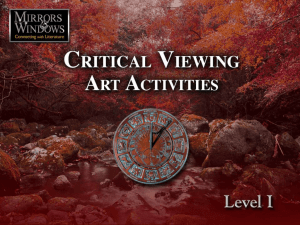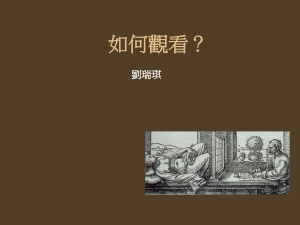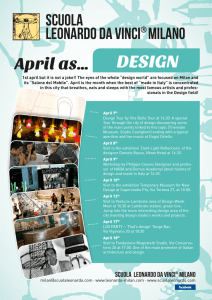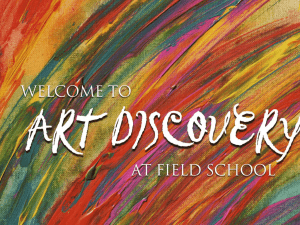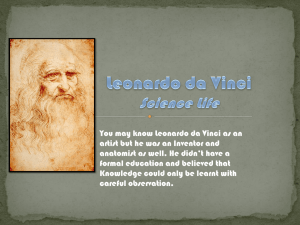The Magnificence and Mystery of Leonardo da Vinci
advertisement
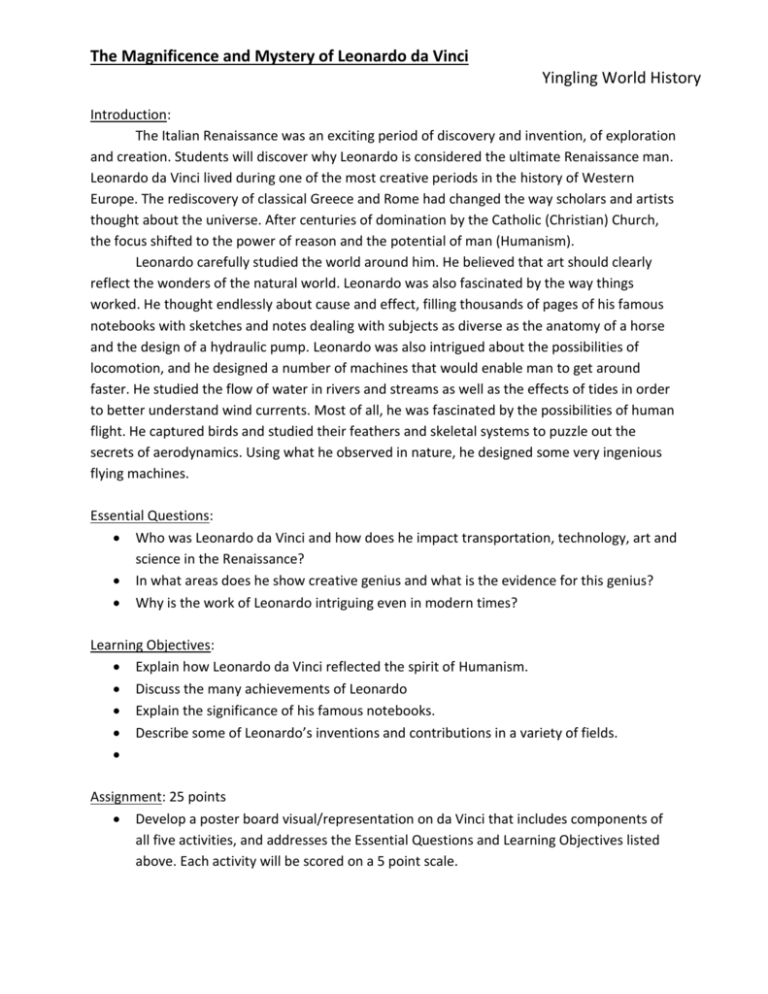
The Magnificence and Mystery of Leonardo da Vinci
Yingling World History
Introduction:
The Italian Renaissance was an exciting period of discovery and invention, of exploration
and creation. Students will discover why Leonardo is considered the ultimate Renaissance man.
Leonardo da Vinci lived during one of the most creative periods in the history of Western
Europe. The rediscovery of classical Greece and Rome had changed the way scholars and artists
thought about the universe. After centuries of domination by the Catholic (Christian) Church,
the focus shifted to the power of reason and the potential of man (Humanism).
Leonardo carefully studied the world around him. He believed that art should clearly
reflect the wonders of the natural world. Leonardo was also fascinated by the way things
worked. He thought endlessly about cause and effect, filling thousands of pages of his famous
notebooks with sketches and notes dealing with subjects as diverse as the anatomy of a horse
and the design of a hydraulic pump. Leonardo was also intrigued about the possibilities of
locomotion, and he designed a number of machines that would enable man to get around
faster. He studied the flow of water in rivers and streams as well as the effects of tides in order
to better understand wind currents. Most of all, he was fascinated by the possibilities of human
flight. He captured birds and studied their feathers and skeletal systems to puzzle out the
secrets of aerodynamics. Using what he observed in nature, he designed some very ingenious
flying machines.
Essential Questions:
Who was Leonardo da Vinci and how does he impact transportation, technology, art and
science in the Renaissance?
In what areas does he show creative genius and what is the evidence for this genius?
Why is the work of Leonardo intriguing even in modern times?
Learning Objectives:
Explain how Leonardo da Vinci reflected the spirit of Humanism.
Discuss the many achievements of Leonardo
Explain the significance of his famous notebooks.
Describe some of Leonardo’s inventions and contributions in a variety of fields.
Assignment: 25 points
Develop a poster board visual/representation on da Vinci that includes components of
all five activities, and addresses the Essential Questions and Learning Objectives listed
above. Each activity will be scored on a 5 point scale.
The Magnificence and Mystery of Leonardo da Vinci
Yingling World History
Use both images and written expression to depict your presentation on Leonardo da
Vinci.
Activity 1. Leonardo da Vinci: Renaissance Man
The term “Renaissance man” refers to someone who has a mastery of many fields. Although he
was multi-talented, Leonardo is best known today for his paintings. And certainly the most
famous of his paintings is the Mona Lisa.
For this section of the assignment you will access two websites on the Mona Lisa.
o First will display the painting from its actual locale in the Louvre Museum
in Paris France. Mona Lisa – Portrait of Lisa Gherardini available through
Edsitement-reviewed Louvre Museum website http://www.louvre.fr/en/oeuvre-notices/mona-lisa-%E2%80%93portrait-lisa-gherardini-wife-francesco-del-giocondo.
o The second comes from New Zealand. Leonardo: The Man – His
Machines. Loadstar’s Lair. Maxine Annabell, 1998-2000.
http://www.lairweb.org.nz/leonardo/mona.html.
Please note that the websites are linked within the Schoology assignment for easy
access.
Consider the following questions when reviewing the websites:
1. What is it about this painting that makes it probably the best known painting in the
world?
2. Leonardo used special art techniques in this painting
Sfumato, which means to fade out, in painting Mona Lisa’s face
Aerial perspective – for the background which has a hazy, mist like quality
Chiaroscuro – a method of painting by using light and shade to define
shapes and forms
3. Who is the Mona Lisa, and how has this question added to the mysterious appeal of the
painting?
4. What other features of the painting are unusual for the Renaissance period, and have
given the painting further mystery?
Activity 2. Man as the Measure of All Things
Now that you have witnessed Leonardo da Vinci, the artist, you are ready to do a bit of research
on this great man and the age in which he lived. Leonardo da Vinci was easily swept up with the
spirit of his times. Drawn to many arenas of creative activity, he plunged into one project after
another, with some amazing results.
The Magnificence and Mystery of Leonardo da Vinci
Yingling World History
1. Read about Leonardo’s Life at Renaissance Man from the Museum of Science in Boston
{hyperlink provided) http://legacy.mos.org/leonardo/bio.html
2. Consider the following questions about his life:
What was his home life like?
Who was Andrea del Verrochio?
Who are some of the famous Italian’s that da Vinci knew and why?
What were Leonardo’s thoughts on vegetarians and left handed people?
What were some of the problems and challenges with his studies of the
human body?
As an inventor, da Vinci the “military engineer” almost always used these
when making new inventions?
What were some of his amazing water inventions – that we consider
commonplace today?
Activity 3. Deciphering Leonardo's Notebooks
From boyhood, Leonardo da Vinci was a keen observer of the world around him. As a young
man, he began the habit of writing notes about his observations. In 1482 he began a wide
variety of scientific research projects ranging from botany and anatomy to military engineering
and geography. He jotted down his ideas and theories, accompanied by detailed sketches, in a
collection of notebooks. In time, he would fill thousands of pages. Leonardo’s notebooks are
not easy reading. The subject matter changes abruptly as a new idea popped into his mind. He
also used strange spellings and abbreviations. And most intriguing, the pages are most easily
read if they are held up to a mirror!
Access Turning the Pages on the Web from the British Library, available through
Museum of the History of Science. Click on Leonardo da Vinci selection.
http://www.bl.uk/onlinegallery/virtualbooks/index.html#
You are able to read and listen to the background information on each page.
Now open the cover and begin to peruse the pages. You can magnify the drawings as
well as the writing. Notice the mirror writing (and the upside-down writing). At first
impression, what do these pages seem to be about?
Now click on Text and read the descriptions. Can you find the “doodles?” Why do you
think Leonardo scattered proverbial sayings and riddles among his more scientific
thoughts? What are the main topics addressed in the pages?
The Magnificence and Mystery of Leonardo da Vinci
Yingling World History
Activity 4. Those Wonderful Flying Machines
Leonardo spent a good deal of time thinking about how people could get around faster—on the
earth, in the water, and even in the air. After studying the anatomies of certain wild creatures
and tinkering around with mechanisms like gears and pulleys, he came up with some designs
for vehicles that were way ahead of his time.
In this section of the lesson you will review the National Museum of Science and
Technology of Leonardo da Vinci in Milan, Italy.
http://www.museoscienza.org/english/leonardo/
Select Leonardo at Museum
Select The Collection of Models
Then select the Armoured Car - What is the purpose of this machine? Can you think of
its modern counterpart? Do you think this machine would have worked? Why or why
not? What animal probably inspired Leonardo to design this machine?
Now click on The Transformation of Water into Steam under Water and Land Machines.
How did Leonardo’s study of the natural world influence his designs of watercraft?
Take a look at the Air Screw – da Vinci’s design of the helicopter. What toy inspired this
machine? Look at the Beating Wing, Flying Ship and Glider with maneuverable tips. How
did all of these inventions attempt to solve the problem of human flight?
Lastly, take a look at the parachute. In what ways is Leonardo’s parachute better than its
modern day counterpart?
Activity 5. Universal Leonardo
You will access the website on Universal Leonardo from the University of Arts in London,
England at http://www.universalleonardo.org/. This website has some interesting games for
you to try out.
1. See what your handwriting would look like in mirror image.
2. If you can you fly across the lake
3. What would your monster look like, and more.
4. Pick at least three things learned while playing these games to reflect on.
The Magnificence and Mystery of Leonardo da Vinci
Yingling World History
Sources Cited:
Leonardo da Vinci: Creative Genius. National Endowment For the Humanities – EDSITEment. April 2014.
http://edsitement.neh.gov/lesson-plan/leonardo-da-vinci-creative-genius
Leonardo: The Man – His Machines. Loadstar’s Lair. Maxine Annabell, 1998-2000.
http://www.lairweb.org.nz/leonardo/mona.html
Mona Lisa – Portrait of Lisa Gherardini, wife of Francesco del Giocondo. The Louvre, Paris,
France – 2014. http://www.louvre.fr/en/oeuvre-notices/mona-lisa-%E2%80%93-portrait-lisagherardini-wife-francesco-del-giocondo
National Museum of Science and Technology of Leonardo da Vinci in Milan, Italy – 2014.
http://www.museoscienza.org/english/leonardo/
Renaissance Man. Museum of Science Boston, Massachusetts 2014.
http://legacy.mos.org/leonardo/bio.html
Turning the Pages on the Web. The British Library Board, 2014.
http://www.bl.uk/onlinegallery/virtualbooks/index.html
Universal Leonardo. University of the Arts, London 2014. http://www.universalleonardo.org


